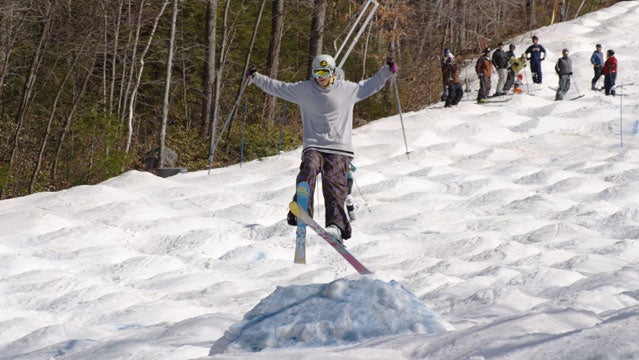“Starting off your winter season with a week of skiing bumps can lead to achy knees, low back pain or stiffness, and sometimes discomfort in the ankles, shins, or hips,” writes Michael Naperalsky, a strength and conditioning coach for the U.S. Ski Team who works with moguls skiers.
Luckily, there’s plenty you can do to minimize your risk of developing pain or a full-blown injury. (Note, however, that falls cause 75 to 85 percent of all skiing injuries, according to the . So if you can stay upright, you’re ahead of the game.)
Below are tips on how to maximize your mogul fun while avoiding a trip to the doctor. Your advisors: Naperalsky, and Olympian and four-time World Pro Tour Champion Chuck Martin, who currently teaches mogul lessons at in Colorado through his company .
GET STRONG: “Members of the U.S. Ski Team prepare for a season of competition with a summer training period filled with methods to improve their strength, power, and fitness. Heavy squats, deadlifts, and step-ups work to strengthen the legs and hips to prepare for repeated impacts and heavy eccentric loads. Explosive jumping exercises act to develop rapid power production while core work focuses on stabilization and anti-rotation exercises,” Naperalsky writes.
Cardiovascular conditioning is important, too. Martin recommends running and cycling with intervals to get in shape for mogul skiing. Mountain biking in particular is ideal, he says, because it’s similar to skiing as it combines short bursts of intense effort with recovery.
START SLOW: “Once the snow flies and it’s time to start skiing, it is important to gradually build up the volume of skiing, progressing over a course of days or weeks. For example, athletes will often ski a light session on day one, more runs on day two, and still more runs on day three, then take off day four to allow for recovery,” Naperalsky writes. “It can take two or three weeks to adjust to the increased training volume and load on your body. Sudden or large increases in volume lead to more aches and pains, while appropriate progression reduces overall fatigue.”
If you’re only hitting the slopes for a few days, make sure to do warm-up runs before diving into the moguls, and try to progress gradually into the hard stuff by knocking off a few blue bump runs first.
POSITION YOURSELF: Proper technique is everything. “Leaning too far back puts a lot of strain on the knees and on the lower back,” Martin says. “Someone with proper technique has shin pressure in their boots, is leaning forward on the balls of their feet, and they’re able to absorb the impact of the moguls. Their knees will come up properly without straining the knees.”
Need help with your technique? Check out Martin’s video on proper position:
CHOOSE THE PROPER EQUIPMENT: While fat skis are all the rage right now, Martin finds they’re harder to maneuver in a tight mogul line than narrower skis, and that they make it more difficult to maintain proper mogul skiing position. “Mogul skiers with proper technique turn in a more upright position—we get most of our turn angle out of our knees and not out of our hips,” Martin says. “That’s the difference between a mogul skiing technique and a regular cruising technique these days.” Shorter skis will also help you maneuver more nimbly through the bumps. Martin’s ski of choice: .��


